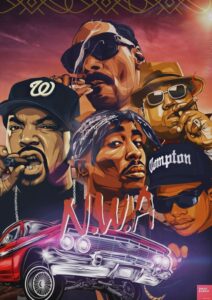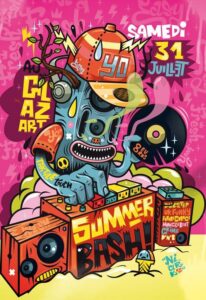“So we live like caged beasts waitin’ for the day to let the rage free. Still me ’til they kill me.” – Tupac Shakur (“Holler If Ya Hear Me” 1993)
Hip-hop was the music of America’s silent civil war, an expression of impoverished rage that’s achingly rich in truth. It’s the soundtrack to the lives of a generation of African-Americans, and the scripture of an uprooted people.
Like millions of people in the 1980s, hip-hop was born in the Bronx; and like millions of white Americans, it would soon leave it. Reverse gentrification from the black boroughs of New York would take funds and public money along with them, setting the stage for a cultural revolution.
As white communities transplanted to suburbs across America, a black migration occurred to metropolitan centres on both coasts. They came with hopes that would never be realised and promised a future that the government found it could not afford. New York would descend into a criminal hellscape, and soon, there would be more gangs than school districts.
It’s from the inhumanity of the NYC projects that the four pillars of hip-hop would emerge. DJ Kool Herc would popularise DeeJaying, mixing and mashing together music that the community couldn’t afford to record on their own.
Break-dancing, graffiti art, and rapping would form the other centrepieces of the movement. While they are still reasonably popular, rap music has been the primary cultural export of the hip-hop moment.
Rap has always been about tragic tales from a first-person perspective. “Old-school Hip-hop” has simple rhyme schemes and rudimentary beats, but the soul of the underlying message still beats long and hard, like a malignant tremor.
Rappers would truly burst onto the world stage with the “New Hip-Hop moment”. The East Coast – West Coast rivalry would fuel this modern-day tale of two cities. Los Angeles and New York would become embroiled in a gang war mediated by everybody from multimillionaire record labels to street-side crack dealers.
The true revolution, however, came on the musical side. Rhyme schemes began to rival Shakespeare and the production quality morphed into subwoofer Beethoven. NWA and the Wu-Tang clan would elevate rap from just party music into something of substance. Lyrical maestros like The Notorious B.I.G (New York) and 2Pac Shakur (LA) would establish rap as a form of poetry, bumping out masterpieces at an impossible rate. Perhaps they knew what was coming, for their deaths in separate, unexplained shootings would bring a sudden end to the rivalry. Millions still mourn their deaths, and the shroud of mystery surrounding the shady circumstances of their passing only adds to the atmosphere of their musical contributions.
However, their indelible legacy would usher rap into the 21st century; through America’s first black president and the BLM movement. Party Music (Dr Dre, Snoop Dogg) would accompany post 9 -11 America as a welcome distraction while White America would gain its first true hip-hop voice in Eminem.
Bling and Glitch Hip-hop would combine drum-style beats with synthesisers, bringing modernity to rap production. The likes of Lil Wayne, Jay-Z, and Dr Dre would bridge the age of New School Hip-hop and modern rap.
The cultural excesses of Millenial America would taper off into a generation of seasoned storytellers led by Kendrick Lamar and J Cole. All the while, alternative artists like Kanye West would fuse jazz, EDM, and gospel music into hip-hop medleys characterized by a cultural awareness that reflected rap’s increasing global prominence. Inspired by the Black Panthers of old, artists like Childish Gambino (of “This Is America” fame) would use their music to shed light on issues like gun violence and police brutality.
Like all art forms, hip-hop grew more introspective with time. The art form would become more conscious at the same time that it became more glamorous. The contrast between the lifestyles of millionaire stalwarts and their primarily underprivileged audience would force artists to come to terms with their upbringings. Voices across the cultural spectrum were broadcasted under the rap banner, with the rise of both white and female rappers. Its rising popularity would make it mainstream and rappers like Jay-Z into billionaires. Their authenticity as a cornerstone of the Black Community was threatened, even as they became aspirations for the American underprivileged.
From being anti-establishment to the most popular musical genre of the generation, some would say that rap has become too polished for its own good.
Rap is now a changed art form. It was born from a need for the economy of words and music. That is no longer the case. But, artists still carry on the tradition of grunge poetry, which is the heartbeat of the genre.
Picket fences and RV’s formed the cultural brownstone of suburban America through the Reagan Years, while Rhythm was what brought black communities together and Violence that tore them apart.
Music is unique in that it accompanies generations. It’s a lens through which human experience can be transmuted. Hip-hop is the elixir of the underprivileged, and the one form of music that has truly paid with blood. For a generation that has known war only from a distance, Hip-hop narrated tales of daily struggle alongside musings on war and the nature of human morality. From bars that came from the pens of deadbeats, to beats that make us feel alive, rap indeed has come full circle.
Written by Arjun Khade for MTTN
Edited by Aditi Atreya for MTTN
Featured image by Omar Sherif
Artwork by Omar Sherif and Seb NIARK1 FERAUT
Sources: PrepScholar, TheSource, Independent, Stanford


Leave a Reply
You must be logged in to post a comment.